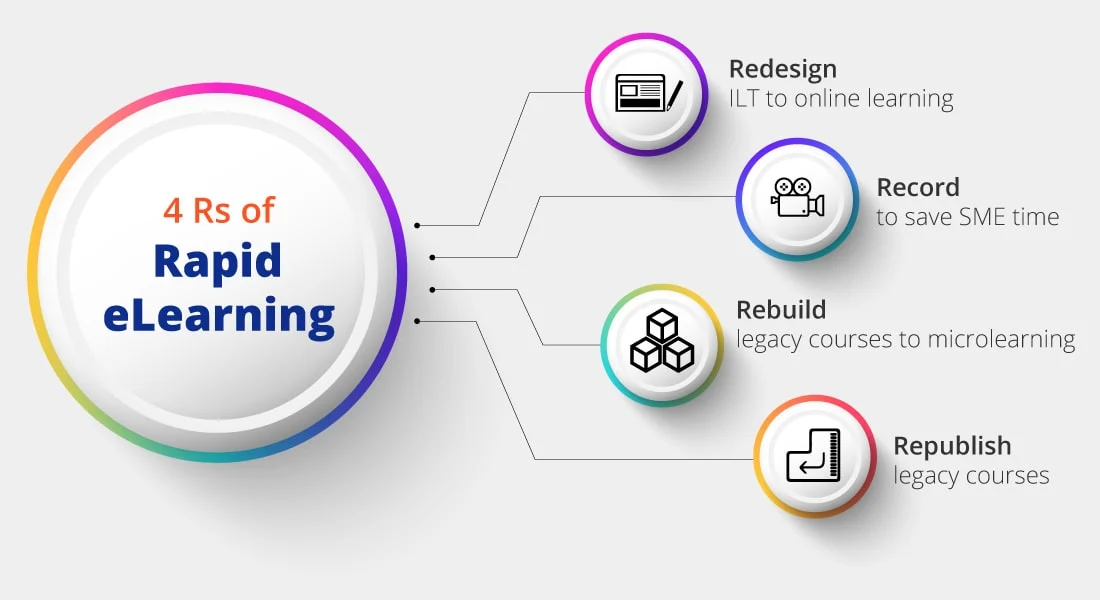In the fast-paced world of education and corporate training, the demand for efficient and timely eLearning solutions has led to the rise of rapid eLearning development models. These models aim to expedite the process of creating online learning content, allowing organizations to adapt swiftly to changing needs and deliver effective training to their audiences. In this article, we will delve into the concept of rapid eLearning development, explore popular models, and introduce the 4 Rs of rapid eLearning: redesign, record, rebuild, and republish.
Understanding Rapid eLearning Development:
Rapid eLearning development is a methodology that prioritizes the swift creation of online learning materials without compromising on quality. Traditional eLearning development processes often involve extended timelines and substantial resources, making it challenging to keep up with the dynamic nature of today’s learning requirements. Rapid eLearning addresses this challenge by leveraging technology and streamlined processes to expedite the development cycle.
Key Features of Rapid eLearning Development Models:
- Reusable Learning Objects:
- Rapid eLearning models often involve the creation of reusable learning objects, modular components that can be repurposed across multiple courses. This approach promotes efficiency and consistency in content development.
- Templates and Authoring Tools:
- The use of templates and authoring tools is a hallmark of rapid eLearning development. Templates provide a consistent structure for content, while authoring tools empower instructional designers and subject matter experts to create content without extensive programming knowledge.
- Collaborative Development:
- Rapid eLearning encourages collaboration among various stakeholders, including instructional designers, subject matter experts, and multimedia specialists. This collaborative approach ensures that diverse expertise contributes to the creation of well-rounded and effective learning content.
The 4 Rs of Rapid eLearning Development:
- Redesign:
- The first “R” involves rethinking and redesigning existing learning content to make it more engaging and effective. This may include updating outdated information, incorporating multimedia elements, or enhancing the overall visual appeal. An exemplary case of the redesign process can be observed in the eLearning initiatives of LinkedIn Learning. The platform frequently revisits and redesigns its courses to ensure they remain relevant and engaging for users.
- Record:
- The second “R” focuses on the recording of content, whether it be through audio narration, video demonstrations, or simulations. This step adds a dynamic and interactive element to the learning experience. An organization that exemplifies the recording process is Coursera. With a vast array of courses spanning various subjects, Coursera utilizes high-quality recorded content to provide a rich and immersive learning experience for its global audience.
- Rebuild:
- The third “R” involves rebuilding or restructuring existing content to enhance its effectiveness. This may include reorganizing modules, improving navigation, or optimizing content for different devices. Khan Academy is a prime example of the rebuilding process in action. The platform continuously refines its content structure to facilitate a seamless learning journey for students across diverse topics.
- Republish:
- The final “R” revolves around republishing the updated and enhanced content. This step ensures that the refined learning materials reach the target audience in a timely manner. Adobe Captivate is a notable example of effective republishing. The platform regularly updates its eLearning content authoring tool, enabling users to republish courses with the latest features and improvements.
Benefits of the 4 Rs of Rapid eLearning Development:
- Agility and Responsiveness:
- The 4 Rs empower organizations to be agile and responsive to changes in content, technology, and learner preferences. This adaptability is crucial for meeting the evolving needs of today’s learners.
- Enhanced Engagement:
- Redesigning, recording, rebuilding, and republishing contribute to creating more engaging and interactive learning experiences. This, in turn, enhances learner engagement and retention.
- Cost-Efficiency:
- The 4 Rs optimize the eLearning development process, resulting in cost savings. By efficiently repurposing existing content and leveraging updated technologies, organizations can deliver high-quality learning solutions without significant financial burdens.
Conclusion:
The 4 Rs of rapid eLearning development models, encompassing redesign, record, rebuild, and republish, provide a structured and effective approach to keeping online learning content relevant and impactful. Real-life examples from LinkedIn Learning, Coursera, Khan Academy, and Adobe Captivate demonstrate the practical application of these principles, emphasizing their role in delivering agile, engaging, and cost-effective training solutions. As the demand for online learning continues to grow, mastering the 4 Rs becomes essential for organizations looking to stay ahead in the dynamic landscape of education and corporate training.











